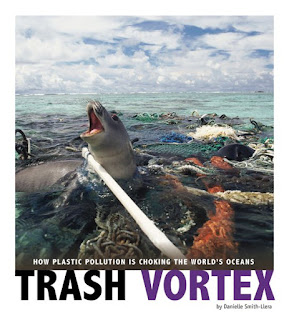Capstone has made a very interesting new series that focuses on pivotal moments in history as captured by photography. They’ve expanded this from history to scientific events as well. The latest set includes catastrophes like oil spills and nuclear explosions and this particular title addresses the rapid spread of micro plastics.
The story begins with Captain Charles Moore’s discovery of a huge soup of micro plastics in a gyre in the Pacific Ocean. Publicized by Moore and other researchers, it became known as the “Great Pacific Garbage Patch” and most people think of it as a giant, floating raft of garbage. The reality is more more complicated however.
Following the history and creation of plastics, from celluloid and bakelite to modern plastics, the author blends in the science of pollution and study of how plastic is filling the oceans and its affect on ocean and land life, including humans. Readers will learn about sea currents, how plastic is broken down into micro plastics, and how these are eaten by animals and then by humans. The science of recycling is addressed, the historical change from reuse to disposal, and the problem of pollution in Third-World countries is also touched on.
Back matter includes a timeline, glossary, and resources.
This is an interesting take on a complex issue. The author does not simplify the issues or imply that there is an easy fix. She addresses the numerous issues in ocean pollution, the many ways it affects our lives, and the ongoing research to discover the full affect and find solutions to the problem.
Verdict: An excellent choice to introduce readers to this complex scientific problem that affects everyone, whether or not they live near the ocean. It also models some excellent research skills and presentation for readers learning to research their own topics. A must-have title to keep your recycling and ecology sections up to date.
ISBN: 9780756557454; Published 2018 by Capstone; Review copy provided by publisher; Donated to the library
The story begins with Captain Charles Moore’s discovery of a huge soup of micro plastics in a gyre in the Pacific Ocean. Publicized by Moore and other researchers, it became known as the “Great Pacific Garbage Patch” and most people think of it as a giant, floating raft of garbage. The reality is more more complicated however.
Following the history and creation of plastics, from celluloid and bakelite to modern plastics, the author blends in the science of pollution and study of how plastic is filling the oceans and its affect on ocean and land life, including humans. Readers will learn about sea currents, how plastic is broken down into micro plastics, and how these are eaten by animals and then by humans. The science of recycling is addressed, the historical change from reuse to disposal, and the problem of pollution in Third-World countries is also touched on.
Back matter includes a timeline, glossary, and resources.
This is an interesting take on a complex issue. The author does not simplify the issues or imply that there is an easy fix. She addresses the numerous issues in ocean pollution, the many ways it affects our lives, and the ongoing research to discover the full affect and find solutions to the problem.
Verdict: An excellent choice to introduce readers to this complex scientific problem that affects everyone, whether or not they live near the ocean. It also models some excellent research skills and presentation for readers learning to research their own topics. A must-have title to keep your recycling and ecology sections up to date.
ISBN: 9780756557454; Published 2018 by Capstone; Review copy provided by publisher; Donated to the library

No comments:
Post a Comment